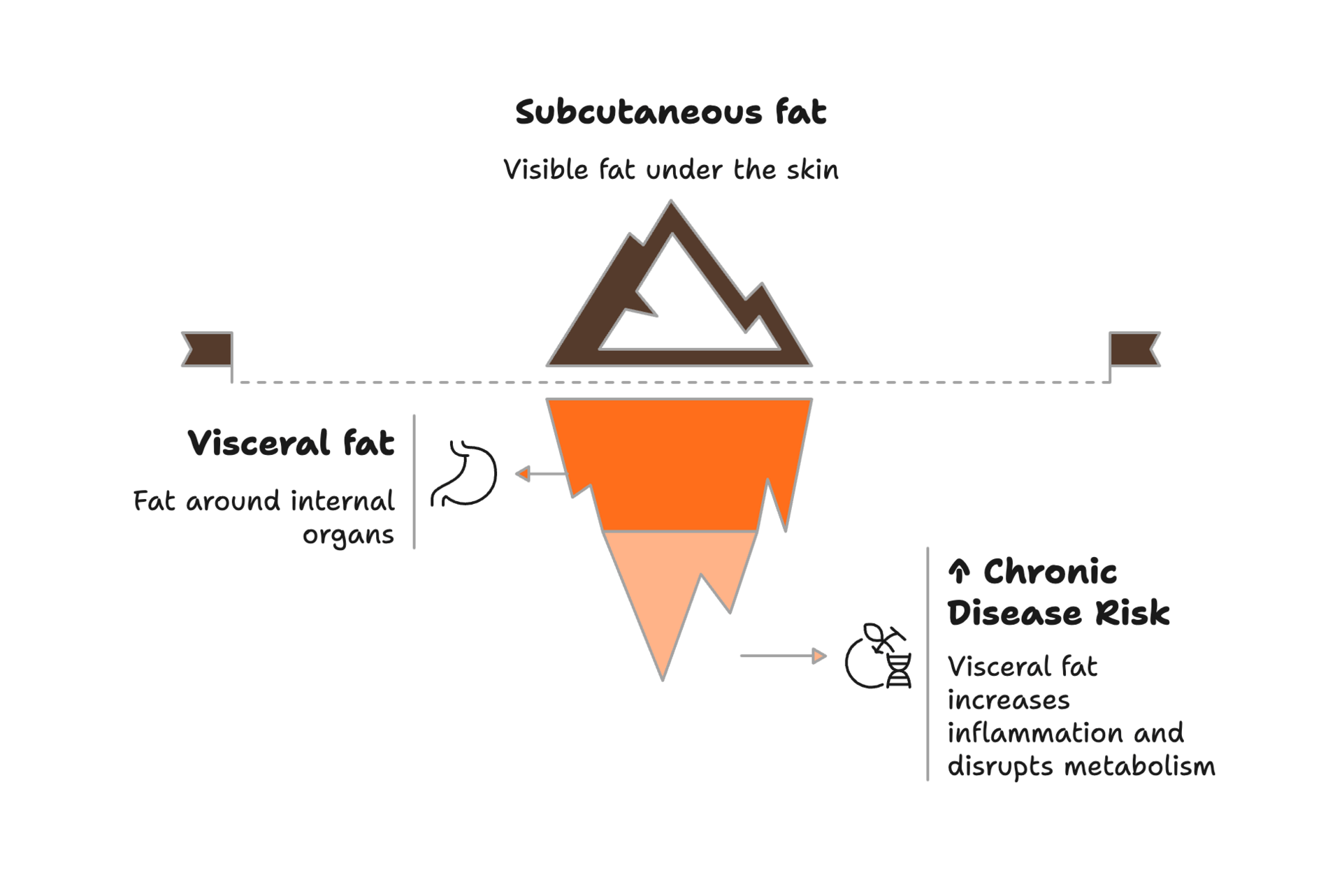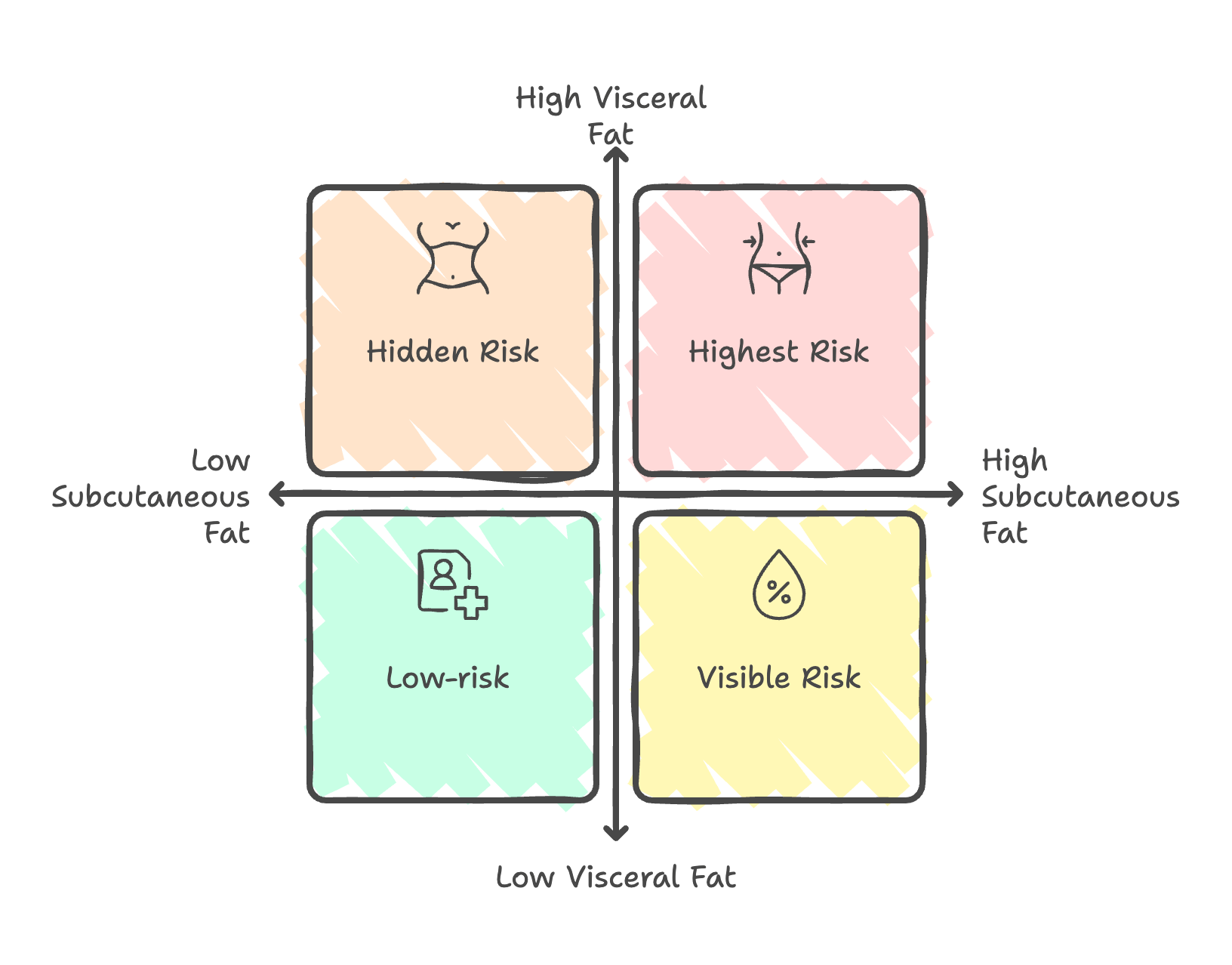- Vital Shift
- Posts
- Your Mirror Lies: The Visceral Fat That Threatens Your Longevity
Your Mirror Lies: The Visceral Fat That Threatens Your Longevity
Issue #4 · Read Time: 5 minutes
Simplifying Health, Amplifying Longevity, One Shift at a Time

We trust the mirror to reflect the truth: our flaws, our strengths, and the subcutaneous fat we’d rather not see. But here’s the twist: your mirror lies beautifully.
The real threat isn’t the fat you can pinch. It’s the fat you can’t—the kind that hides around your organs and quietly fuels trouble.
What Needs to Shift?
Standing in front of patients day after day has taught me something profound: what we can't see often matters more than what we can.
I’ve seen “fit” appearing individuals crumble under the weight of health burdens, while those labelled by society as “overweight” carry surprising metabolic health, all because of where their fat calls home.
The Fat Storage Apartment 🏢
Not all body fat is equal. Where it’s stored makes all the difference.
Imagine your body as a high-rise apartment:
Subcutaneous fat—the kind you can pinch under your skin and see in the mirror—is like your body’s basement storage unit.
It’s where your body tucks excess energy from food and keeps it out of trouble.
It might taint your beach photos and taunt your mirror, but metabolically, it’s mostly harmless1.
But safe, basement storage space is finite. Once it’s full, the excess energy has to be stored somewhere. So, it spills into your living room, blocks hallways, and creates hazards. That’s visceral fat.
Visceral fat is the overflow once your basement storage is maxed out. It wraps around your internal organs, and turns the clean “living space” in your body into a hazard zone.
This clutter is out of sight and wraps around your liver, pancreas and intestines.
Unlike its less harmful cousin (subcutaneous fat), visceral fat doesn’t just sit there. It’s the seedbed of chronic disease and rewires your metabolism against you.

The Double Deception 🎭
This is where the mirror and weight scale lead people (and most doctors) astray.
Your scale spits out a number, but it doesn’t tell you how that weight is distributed. How much of it is muscle? Subcutaneous fat? Visceral fat? The scale is blind to the details.
Worse, it seduces you into thinking any drop in weight is a win (as explored in Issue #3, that mindset can drive you down the dangerous path of muscle loss).
Your mirror plays a similar trick.
A slim waistline and toned frame might seem like success, but it may be a beautiful facade hiding deeper chaos. Even if your abs ripple perfectly, visceral fat might be lurking around your organs and staging a silent takeover.
This is the double deception. Two people with the same weight and appearance can have radically different risk profiles.
One person might have plenty of subcutaneous fat, but little visceral fat.
The other, despite looking lean, has limited safe storage and ends up with more fat packed around the organs (visceral), raising risk in ways neither the mirror nor the scale can show.
That’s why you can’t judge metabolic risk just by looking in the mirror or the scale. How much fat you carry does matter, but where it’s stored matters more.

Some Basements Are Bigger Than Others 📦
Some people genetically inherit large basements. They might look slightly overweight, but they have the capacity to park the excess energy under the skin, where it causes the least harm.
Others inherit broom closets for storage space. They might look slim and lean, but run out of safe, subcutaneous (under the skin) storage early. Any extra fat spills into the “living space” (visceral fat), wrapped around organs, quietly sabotaging their health.
Ironically, it’s the slim, “naturally lean” people who are often the last to realize they’re at risk, because their bodies don’t give any outward warning.
What You Can’t See Can Hurt You 🫣
This is why so many health problems develop quietly, in people who think they’re ‘winning’ on the surface. Once visceral fat sets up camp around your organs, it becomes the lead architect of chronic disease3:
🔥 It Fuels Inflammation
Each pound of visceral fat is like a tiny arsonist, sparking low-grade fires in your body's forest— feeding heart disease, diabetes, and cancer.1
📉 It Corrupts Your Metabolism
It interferes with insulin signalling, spiking blood sugar, and setting the stage for diabetes and accelerated aging.2
⚠️ It Advances Fatty Liver Disease
The fat infiltrates your liver4, crowds your pancreas and increases risk of mortality and metabolic syndrome.
You can only change what you’re willing to see. Mirrors and scales aren’t useless; just incomplete. Body composition scans fill in more of the picture: how much fat you carry, and where its stored.
Your Next Move
🔬 Peek Behind the Curtain
Common Trap: Trusting that flat abs = metabolic health.
The Tool: Body composition scans (like DEXA) reveal what your mirror and scale would rather ignore—a map of where your fat lives.
Power Move: Book a DEXA scan and use it to guide your next strategic move.
📊 Cut Calories, Not Corners
Common Trap: Randomly slashing calories, which forces your body to burn both fat and precious muscle; like demolishing the house to fix a leaky roof.
The Strategy: Create a small calorie deficit (200-300 calories daily) by eating fewer calories than you burn (use MyFitnessPal to find your baseline).
Power Move: Keep protein high (~1-1.5g per kg of body weight), and maintain strength training. That’s how you keep A-list talent (muscle) and boot the party-crashers (visceral fat).
💪 Flex Your Fat-Burning Muscles
Common Trap: Focusing only on "cardio" and ignoring muscle. The less muscle you keep, the harder it is to lose visceral fat (and keep it off).
The Strategy: Strength training is your body's casting director: it keeps star performers (muscle) and cuts the understudies (visceral fat).
Power Move: Just 15 minutes of daily resistance training (squats, planks, push-ups) signals your body: keep the muscle, lose the fat.
🥗 Let Fibre Do the Heavy Lifting
Common Trap: Running on low-fibre foods, which spike your blood sugar and expedite fat gain.
The Strategy: Fibre is your body's traffic police, minimizing blood sugar surges and keeping fat storage in check.5
Power Move: Aim for 25–30g of fibre daily.
⏰ Time Your Final Call
Common Trap: Treating your body like it's always open for business. (Even as a doctor, I'm guilty. Hello, overnight call!)
The Strategy: Insulin sensitivity drops before sleep, when you’re least equipped to handle calories.6 Eating late is like trying to deliver packages when the warehouse is closing. They get dumped where you least want them—around your organs.
Power Move: Close the kitchen 3 hours before bed. Give your body's night shift workers (sleep hormones) a clear path to do their job without running into the day crew (digestion).
Remember: The most dangerous fat isn't the one ruining your reflection, it's the one rewriting your future. Don't chase the story your mirror tells you, or get tricked by your scale. Write the memoir your body deserves.
Who Else Is Talking About it?
Not all fat is created equal. In this short video, Dr. Peter Attia breaks down why visceral fat is the real villain lurking in your body, and why it’s not where you carry it, but what it does that makes it so dangerous.
We’re really well designed to store fat in our subcutaneous space… But we’re not designed to have fat around our organs, inside our liver, around our heart, pancreas, and kidneys. Those fat stores are highly inflammatory and are the most under-appreciated driver of cardiovascular disease risk.
Unlock the Bigger Picture 🔑
This is Chapter 4 in your evolving health playbook, each issue building on the last to help you piece together the full picture of your health journey. Last week, we unmasked the hidden fat that rewrites your health story, and the week before, we exposed what your scale isn't telling you.
I'm a Toronto doctor caring for older adults in hospitals and nursing homes, while spending my spare time digging into longevity science. I'm here to share what I'm learning. No fancy jargon, just practical insights to help you read your body’s early signals. Think of me as your friendly guide, figuring this out alongside you. Medicine has changed, but how we practice it hasn't caught up. That's why I'm here: to help you edit your health story while the early drafts are still open.
1 While subcutaneous fat is far less harmful than visceral fat, very high amounts of total fat still carry independent risks. Large subcutaneous depots can contribute to mechanical stress (e.g. sleep apnea, joint disease) and, when severely expanded, can spill inflammatory signals and worsen insulin resistance. In other words, subcutaneous fat is the safer parking lot for energy — but even a “safer” lot has limits.
Reply